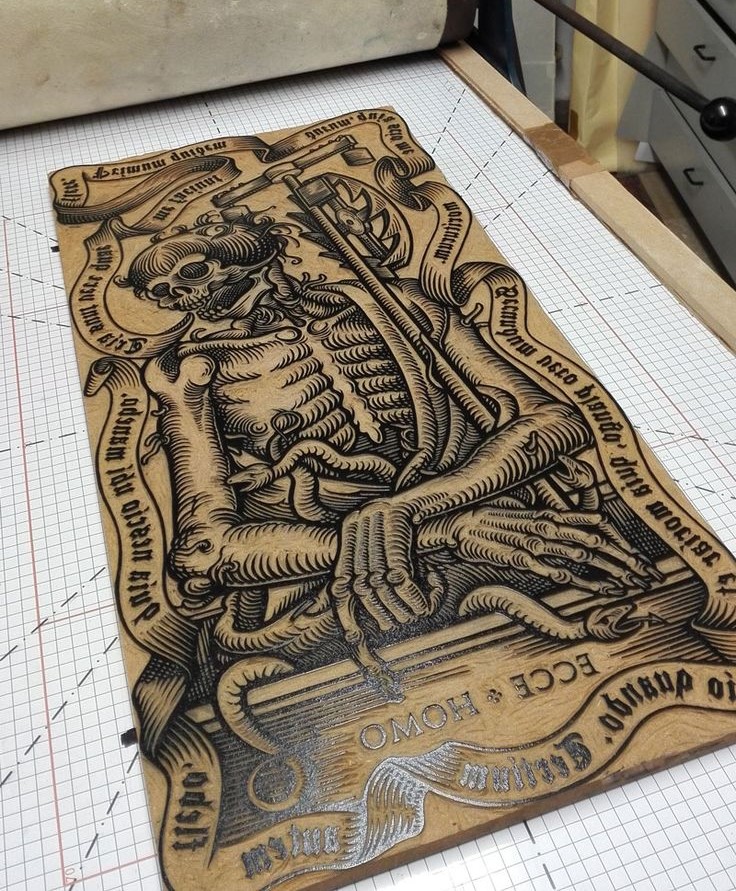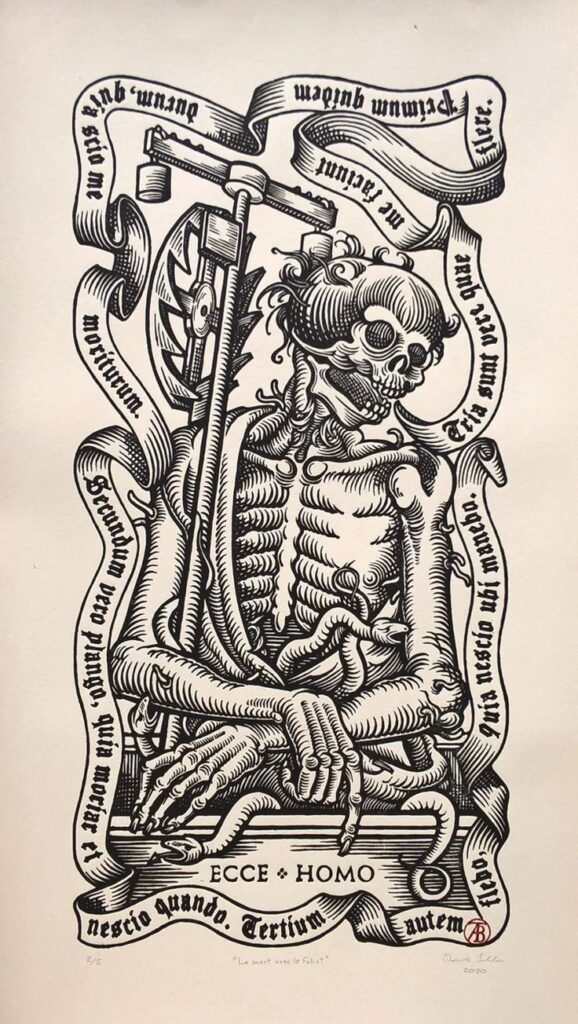Wood Engraving
Wood Engraving is a printmaking technique that involves carving an image onto the surface of a block of wood. It is distinct from woodcut, another form of relief printing, in that it uses the end grain of wood rather than the side grain. This allows for finer lines and greater detail in the resulting prints.
History
Wood Engraving holds a significant place in the field of printing and visual communication, with its origins dating back to ancient times. However, it wasn’t until the fifteenth century in Europe that Wood Engraving began to emerge as a distinct art form.
Initially used for printing images alongside text in books, Wood Engraving gained prominence during the Renaissance, particularly in Germany and Italy. The process involved carving a design or image into the surface of a wooden block, typically using tools like burins or gravers.
These meticulously crafted blocks could then be inked and pressed onto paper to produce prints. Wood Engraving experienced a surge in popularity during the sixteenth and seventeenth centuries, becoming a favoured medium for illustrating books, pamphlets, and broadsides.
Wood engravers such as Albrecht Durer and Hans Holbein the Younger made significant contributions to the development of Wood Engraving as an art form, showcasing its potential for intricate detail and expressive imagery. The technique continued to evolve over the centuries, with innovations in tools, materials, and printing processes.
While Wood Engraving eventually gave way to other printmaking methods like etching and lithography, its legacy endures, with contemporary artists still exploring its unique aesthetic and expressive possibilities.
Today, Wood Engraving remains celebrated for its historical significance, technical craftsmanship, and timeless appeal in the realm of visual art and graphic design.
How to Engrave Wood Step by Step.
Wood Engraving Process
The wood engraving process is a printmaking technique that involves carving an image onto the surface of a wood block, which is then inked and transferred onto paper. Here are the basic steps involved in the Wooden Engraving printing process:
Design and Preparation
The artist sketches or transfers the desired image onto a smooth surface of a wood block, typically made of hardwood such as boxwood or maple. The surface is carefully prepared to ensure it is smooth and free from imperfections.
Engraving
Using specialized Engraving tools such as burins or gravers and a wood engraving machine, the artist meticulously carves the design into the surface of the wood block. This requires precision and skill to create fine lines, textures, and details within the image.
Inking
Once the engraving is complete, ink is applied to the surface of the wood block using a roller or brayer. The ink is evenly distributed over the raised areas of the design while the carved recesses remain free of ink.
Printing
A sheet of paper is carefully placed onto the inked surface of the wood block. Pressure is applied evenly and consistently using a printing press or by hand, allowing the paper to absorb the ink and transfer the image from the wood block onto the paper.
Pulling the Print
The paper is carefully peeled away from the wood block, revealing the printed image. This step requires delicacy and precision to ensure that the print is clear and free from smudges or distortions.
Drying and Finishing
The printed paper is allowed to dry thoroughly before any additional finishing touches are applied. Depending on the desired effect, the artist may choose to hand-color the print, trim the edges, or sign and number it as part of a limited edition.


Techniques of Wood Engraving
Apart from the traditional process of engraving wood, there are other techniques used in Wood Engravings:
White Line Woodcut
In this technique, the artist cuts away the parts of the woodblock that they want to remain white, leaving the lines and shapes raised. It’s a variation of woodcutting that produces images with distinct white lines against a dark background.
End grain Woodcut
Unlike traditional woodcuts which use side grain, end grain woodcuts utilize the end grain of the woodblock. This allows for finer details and sharper lines due to the denser nature of the end grain.
Wood Engravings with Multiple Blocks
Artists often use multiple woodblocks to create a single image with different colors or layers. Each block is carved separately to represent a specific part of the image, and they are printed in succession to create a cohesive final artwork.
Reduction Woodcut
In this technique, a single woodblock is gradually carved away and printed in stages to create a multi-colored print. After each color is printed, more of the block is carved away, making it impossible to print additional copies once the process is complete.
Polymer Wood Engravings
This modern variation involves using polymer plates instead of traditional woodblocks. The artist creates the image digitally or by hand, and it is then transferred onto the polymer plate. The plate is then mounted onto a wooden base for printing.
The wooden engraving technique of printmaking stands as a timeless testament to the ingenuity and artistry of human creativity. Its core differentiator lies in the meticulous process of carving intricate designs and images into the surface of a woodblock, resulting in prints of unparalleled detail and depth. Unlike other printmaking methods, such as woodcut or etching, wood engraving requires a delicate balance of skill, precision, and patience.
The historical significance of wooden engraving cannot be overstated. From its origins in ancient China to its widespread adoption in Europe during the Renaissance and beyond, this technique has played a pivotal role in the dissemination of art, literature, and ideas across cultures and generations. What sets wood engraving apart is its ability to capture the finest nuances of light and shadow, allowing artists to express a remarkable range of textures and tones with remarkable clarity. By utilizing the hard, end-grain surface of the woodblock, engravers can achieve exquisite precision and control, producing prints that are both visually stunning and emotionally evocative.